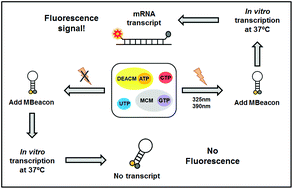Dual-color control of nucleotide polymerization sensed by a fluorescence actuator†
Abstract
Spatial and temporal control of molecular mechanisms can be achieved using photolabile bonds that connect biomolecules to protective caging groups, which can be cleaved upon irradiation of a specific wavelength, releasing the biomolecule ready-to-use. Here we apply and improve a previously reported strategy to tightly control in vitro transcription reactions. The strategy involves two caging molecules that block both ATP and GTP nucleotides. Additionally, we designed a molecular beacon complementary to the synthesized mRNA to infer its presence through a light signal. Upon release of both nucleotides through a specific monochromatic light (390 and 325 nm) we attain a light signal indicative of a successful in vitro transcription reaction. Similarly, in the absence of irradiation, no intense fluorescence signal was obtained. We believe this strategy could further be applied to DNA synthesis or the development of logic gates.


 Please wait while we load your content...
Please wait while we load your content...